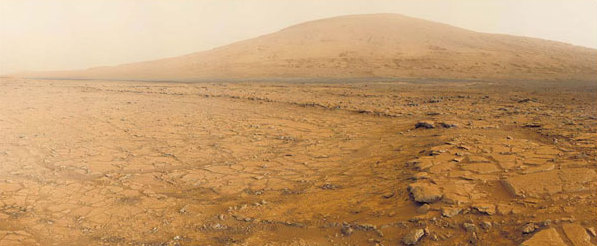One Earth year on Mars, rover plods on
Updated: 2013-08-18 07:51
By Kenneth Chang(The New York Times)
|
|||||||||
|
NASA's Curiosity rover is rambling on Mars, slowly heading toward Mount Sharp, whose rocks could provide clues on whether the planet was ever habitable. Panorama by The New York Times; images by NASA |
On the first anniversary of its landing, halfway through its primary mission to Mars, NASA's Curiosity rover still had a long way to go.
To be more specific, seven kilometers. That is the distance to the foothills of Mount Sharp, a 5,500-meter mountain whose rocks could provide clues to a time on Mars when life could have thrived.
Because Curiosity is driving at a careful pace of up to 90 meters a day, the journey will take eight or nine months.
For now, science is secondary as Curiosity crawls across a barren, largely uninteresting landscape.
"Pretty much pure driving, pedal to the metal," said John P. Grotzinger, the mission's project scientist.
An interactive feature at nytimes.com/science offers a chronology of where Curiosity has been and what it has done; new images and information will be added as the rover progresses.
According to NASA, Curiosity has already traveled more than 1.6 kilometers, taken more than 36,700 images and fired 75,000 laser shots to analyze rocks and soil.
The first day - or sol, the term for a Martian day, which is about 40 minutes longer than a day on Earth - began in the early morning of August 6, 2012. (At mission control at NASA's Jet Propulsion Laboratory in Pasadena, California, it was late on August 5.)
The spacecraft carrying Curiosity pierced the top of the Martian atmosphere at more than 21,000 kilometers per hour.
In precisely choreographed maneuvers so risky that NASA called them "seven minutes of terror," Curiosity was dropped to an undamaged standstill on the surface.
The rover, roughly the size of a car, ended up right where it had been aimed - within Gale Crater, a 155-kilometer-wide scar from an asteroid impact at least 3.5 billion years ago. In that time layers of sediment filled much of the crater, which were then somehow carved away, leaving Mount Sharp at the center.
Observations from orbit pointed to the presence of clay minerals at the base of the mountain, named in honor of Robert P. Sharp, a prominent geologist and Mars expert. Because clays form in water that has a neutral pH, that made Gale Crater a promising place to look for signs that Mars could have once been hospitable for life.

Before pointing it toward Mount Sharp, Dr. Grotzinger's team decided to send Curiosity on a detour to investigate terrain that looked to be an intriguing confluence of three different rock types. Along the way, Curiosity spotted what looked like an ancient streambed. At the site, in the first rock it drilled on February 8 (Sol 182), it struck the jackpot - clays.
This rock in this part of Mars formed in watery conditions that were surprisingly Earthlike. "Unquestionably, Mars was a habitable planet in its ancient past," Dr. Grotzinger said.
Curiosity, however, does not have instruments that can directly search for life, past or present.
Although the primary mission is scheduled for only two years, Curiosity could be exploring Mars far longer. "It looks great," said Jennifer H. Trosper, the deputy project manager. "I think over all the rover has worked better than expected."
But lest anyone think that everything on the $2.5 billion mission would always work perfectly, a computer memory glitch in late February knocked Curiosity out of action for a couple of weeks. As Dr. Grotzinger said, "This is a very sober reminder that the rover ultimately has a finite lifetime."
The New York Times
(China Daily 08/18/2013 page11)
